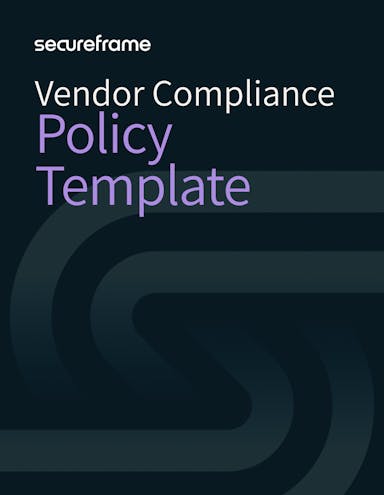
Why Vendor Compliance Matters (and How to Make It Easier)
Emily Bonnie
Senior Content Marketing Manager
Rob Gutierrez
Senior Cybersecurity and Compliance Manager, CISA, CCSK, CMMC RP
From cloud storage providers to outsourced IT services, third-party vendors and service providers play a vital role in helping organizations scale, innovate, and stay competitive. But working with third parties also introduces risk, especially when it comes to security and regulatory compliance. In the first half of 2024 alone, U.S. regulators issued $1.876 billion in penalties for compliance violations, with a significant portion related to third-party risks.
Regulators, customers, and partners expect your organization to manage third-party risk with the same rigor you apply to your own systems. When a vendor fails to meet security or compliance obligations it’s not just their problem, it’s yours. Vendor compliance requires an ongoing, structured approach to reduce legal exposure, prevent costly disruptions, and protect your organization’s reputation.
In this article, we’ll explore the risks of vendor non-compliance, the biggest challenges companies face in managing vendor compliance, and how to build an effective vendor compliance program.
Why does vendor compliance matter? The cost of non-compliance

Vendor non-compliance can have serious consequences for your business. Even if the failure occurs outside your company’s direct control, regulators and customers may still hold you responsible.
Case in point: in 2023, a major healthcare provider was fined over $1.2 million when a third-party billing vendor failed to secure patient data, leading to a HIPAA breach. The provider was held liable, even though the breach occurred outside their systems.
One of the most immediate vendor compliance risks is the potential for these kinds of regulatory penalties. Many compliance frameworks and regulations, including HIPAA, PCI DSS, and GDPR, require organizations to ensure that any third parties handling sensitive data or critical systems meet the same security and privacy standards. If a vendor violates those standards, your organization could be fined, investigated, or sued.
Security breaches are another significant concern. A vendor with poor cybersecurity practices can create a weak link in your supply chain, giving attackers a way to infiltrate your systems. This is more common than many organizations realize. 98% of organizations have a relationship with a third party that has experienced a data breach.
Beyond legal and security risks, vendor non-compliance can disrupt your operations. If a key partner is suspended or shut down due to a compliance issue or security incident, your access to essential services or data may be delayed or cut off entirely. The result is lost productivity, unhappy customers, and strained internal resources.
Vendor compliance is not just about meeting external obligations; it’s about protecting the integrity, security, and continuity of your business.
Common vendor compliance management missteps
Most organizations understand that vendor compliance is important, but that doesn’t mean they’re doing it effectively. In practice, a few common mistakes consistently open businesses up to risk.
One of the most frequent missteps is assuming a vendor is compliant simply because they’re a well-known provider or claim to follow best practices. Without documentation, verification, and contractual enforcement, those claims offer little protection when something goes wrong.
Another common mistake is treating third-party compliance as a one-time task during vendor onboarding. In reality, a vendor’s compliance posture can change as they update systems, expand services, or experience staffing or ownership changes. Failing to periodically reassess vendors leaves organizations blind to emerging risks.
Many businesses also struggle with vague or inconsistent contract language. If compliance obligations, breach notification timelines, or audit rights aren’t clearly defined in writing, you’ll have little leverage if a vendor fails to meet expectations.
Manual tracking methods compound these problems. When vendor assessments are spread across spreadsheets, emails, and shared drives, it becomes difficult to see which vendors are compliant, who is overdue for review, or whether any critical documentation is missing.
These mistakes are often rooted in structural challenges: poor visibility across the vendor landscape, inconsistent internal processes, and a lack of resources to scale oversight. Solving these problems requires a structured approach that starts with a formal vendor compliance program.
How to create an effective vendor compliance program
A strong vendor compliance program creates consistency, accountability, and structure. It gives your organization the tools to spot issues early, respond quickly, and demonstrate due diligence during audits and assessments.
And it doesn’t have to be complicated. With a clear, scalable process, you can integrate vendor compliance checks throughout the lifecycle of every third-party relationship. Let’s walk through what that looks like in practice.
Step 1. Understand your vendor compliance requirements
Understanding your compliance requirements for third-party vendors starts with clarifying your own obligations first, then mapping how those extend to vendors based on the data they access, the services they provide, and the regulations that apply to your business.
Start by identifying which cybersecurity frameworks, regulations, or internal policies your business is subject to. Once these are clearly defined, you can determine how these obligations extend to your third-party vendors, especially those who process, store, or access sensitive data or systems on your behalf.
| Common regulatory and commercial frameworks with third-party compliance requirements | |
|---|---|
| HIPAA | Requires covered entities to have Business Associate Agreements (BAAs) with vendors who handle protected health information (PHI). |
| GDPR | Requires data controllers to ensure that data processors meet GDPR obligations and includes specific contract requirements. |
| CCPA/CPRA | Requires contracts with service providers to include specific compliance-related terms. |
| PCI DSS | Requires that all third parties handling payment card data also comply with applicable PCI DSS requirements. |
| NIST 8000-53 | Vendors and suppliers must meet applicable security and privacy controls if they impact system security or handle federal information. |
| NIST 800-171/CMMC 2.0 | Requires defense contractors to ensure their subcontractors meet the same cybersecurity requirements if they handle Controlled Unclassified Information (CUI). |
| FedRAMP | Cloud service providers must ensure any subcontractors meet FedRAMP requirements if they are part of the service delivery. |
| ISO 27001 | Requires organizations to assess and address risks from third-party vendors as part of their ISMS. |
| SOC 2 | While not prescriptive, SOC 2 assessments often consider third-party risk management as part of the Trust Services Criteria (especially security and availability). |
Once you’ve identified the frameworks or laws that apply, check whether they:
- Require flow-down clauses (e.g., CMMC 2.0, NIST 800-171)
- Expect you to perform due diligence before and during vendor engagement (e.g., SOC 2, ISO 27001)
- Impose contractual obligations on your vendors (e.g., GDPR’s data controller/data processor contracts)
- Hold your organization liable for breaches or violations by vendors (e.g., HIPAA Business Associate Agreements)
- If any vendors store or process critical relevant data (i.e. PHI for HIPAA or Cardholder Data for PCI)
Step 2. Classify vendors based on risk and exposure
Not every vendor presents the same level of risk, so it’s important to classify them based on their relationship to your business, systems, and data.
Start by developing a vendor classification framework with tiered risk categories (typically low, medium, and high). To properly classify vendors, consider three primary factors:
- Data sensitivity: Does the vendor access, store, or process sensitive information such as personally identifiable information (PII), protected health information (PHI), financial data, or Controlled Unclassified Information (CUI)? If so, they are likely high risk.
- System access: Does the vendor have privileged access to your internal systems, production environments, or networks? Even if they don’t process sensitive data, access to critical systems can pose serious risk.
- Business criticality: How essential is the vendor’s product or service to your core operations? A disruption in a key SaaS platform or infrastructure provider could halt customer delivery or compliance reporting.
Other factors to consider include regulatory exposure (such as subcontractors under CMMC 2.0), geography (such as cross-border data transfers under GDPR), and whether the vendor relies on sub-processors.
Once classified, vendors in the high- and medium-risk tiers should be subject to more rigorous onboarding processes, documentation, and monitoring procedures.
Step 3. Determine what evidence or controls you need from vendors to prove third-party compliance
Once vendors are classified, the next step is determining what proof of compliance is appropriate based on their risk tier and your own compliance frameworks.
Start by reviewing your own compliance requirements. Most regulatory or commercial frameworks include third-party risk management controls. These may specify minimum expectations for vendor security practices, breach notifications, incident response, and data handling.
From there, define what types of evidence you’ll accept to demonstrate compliance. Common documentation includes:
- Current SOC 2 reports or ISO 27001 certifications
- Completed security questionnaires aligned with your requirements
- Copies of key policies, such as access control, data retention, and incident response
- Evidence of employee training on cybersecurity and data privacy best practices
- Penetration test reports or third-party risk assessments
- Contractual documentation, such as a BAA, Data Processing Agreement (DPA), or flow-down clause
To maintain consistency, many organizations create a vendor evidence checklist by risk tier, so procurement and security teams know what to collect, and vendors know what to provide.
For added assurance, consider requiring vendors to complete annual reassessments or submit updated documents as certifications or policies expire.
Step 4. Define contractual and policy requirements
Clear contractual language is one of the most effective ways to enforce vendor compliance obligations. All contracts with vendors that handle sensitive data or critical systems should include specific language around:
- Security controls the vendor must implement, such as encryption, multi-factor authentication, and secure development practices
- Audit rights, including your ability to request documentation or perform an independent assessment
- Breach notification timelines, typically 24 to 72 hours, depending on your regulatory obligations
- Incident response cooperation, including the vendor’s role in investigation and mitigation
- Compliance with any specific frameworks, such as SOC 2, GDPR, or CMMC 2.0
- Termination clauses, allowing you to exit the contract if the vendor fails to meet compliance standards
In addition to external contracts, internal vendor management policies should document how compliance obligations are identified, enforced, and monitored. This helps ensure your team follows a consistent process and supports accountability during audits.
Step 5. Conduct periodic vendor risk assessments to verify compliance in practice
Once you’ve defined your compliance requirements, establish a consistent, repeatable process for assessing vendor compliance throughout the entire relationship. This process should include collecting standardized security questionnaires, reviewing third-party audit reports, scheduling annual compliance reviews, and tracking deadlines for expiring documentation.
Reassess vendors regularly to ensure their compliance posture remains aligned with your expectations. This is especially important when there are changes in regulatory requirements, vendor ownership, service scope, or system access.
By integrating these compliance checks into your broader vendor risk assessment process, you gain a more complete and accurate view of third-party risk, reducing the chance of missed requirements and improving your audit readiness.
Recommended reading

The Ultimate Guide To Effective Vendor Risk Assessments: 47 Questions to Ask to Protect Your Business
Step 6. Formalize your process in a vendor compliance policy
Finally, formalize all of the above into an internal vendor compliance policy. This document should outline your organization’s vendor compliance requirements, assessment procedures, roles and responsibilities, and the process for managing vendor issues or escalations. A clearly written policy helps your internal team follow a consistent, repeatable approach, and serves as a reference during audits.

Vendor compliance policy template
Download our free Vendor Compliance Policy Template to document your requirements, set clear expectations, and build a repeatable process for managing third-party compliance risk.
Step 7. Use a Vendor Risk Management (VRM) or compliance automation platform
Managing vendor compliance manually may work for a handful of vendors, but it quickly becomes unmanageable at scale. Manual tracking methods can result in missed deadlines, outdated documentation, and a lack of consistency in how risk assessments are conducted.
Vendor Risk Management (VRM) solutions are designed to help organizations identify, assess, and mitigate risks associated with third-party vendors. They typically focus on risk scoring, security questionnaires, and lifecycle management of vendor relationships.
However, traditional VRM tools often fall short when it comes to ongoing compliance oversight, especially when you need to collect audit-ready documentation, monitor changes to risk posture, or keep pace with shifting regulatory requirements.
Compliance automation platforms are built not just to assess risk, but to ensure vendors remain compliant over time. They help teams:
- Collect and centralize vendor compliance documentation
- Automatically track expiration dates for certifications or evidence
- Send reminders for missing or overdue documentation
- Flag high-risk vendors based on real-time changes
- Align vendor oversight with internal frameworks like SOC 2, ISO 27001, HIPAA, or CMMC
By automating your vendor compliance workflows, you can streamline evidence collection, set up automated reminders for renewals or missing documentation, and maintain a real-time view of each vendor’s compliance status.
These platforms often include dashboards that allow you to quickly identify non-compliant vendors or spot trends in risk exposure. Some tools even integrate with your ticketing, contract management, or asset inventory systems so that vendor compliance becomes a seamless part of your existing workflows.
Automation not only saves time and reduces the burden on internal teams, it also improves accuracy, reduces human error, and ensures you can demonstrate continuous due diligence in the event of an audit or security incident.
Secureframe’s vendor risk management and compliance solutions
Secureframe makes it easier to manage and monitor vendor compliance across your entire third-party ecosystem. Our platform provides a centralized system for collecting, reviewing, and tracking vendor documentation, including security questionnaires, audit reports, and certifications.
With Secureframe, your team can automate key workflows, such as scheduling compliance reviews, requesting updated evidence, and flagging vendors whose risk profile has changed. Real-time dashboards provide visibility into vendor risk and compliance status, helping you make informed decisions and reduce risk exposure.
Whether you’re working with a small group of service providers or managing hundreds of vendors across departments, Secureframe gives you the tools to scale your vendor compliance program securely.
Use trust to accelerate growth
FAQs
What does vendor compliance mean?
Vendor compliance refers to the process of ensuring third-party vendors follow your organization’s security, regulatory, and contractual requirements, especially when they access sensitive data or systems.
What does a vendor compliance specialist do?
A vendor compliance specialist manages third-party oversight by reviewing contracts, collecting compliance documentation, conducting risk assessments, and ensuring vendors meet regulatory and internal standards.
How to monitor vendor compliance?
Monitor vendor compliance by conducting regular risk assessments, reviewing evidence like audit reports and certifications, tracking key dates, and using automation tools to flag changes or expired documentation.
What is the KPI for vendor management?
Common KPIs and performance metrics include percentage of high-risk vendors assessed, time to complete vendor reviews, number of overdue assessments, and compliance documentation completion rate.
How do you ensure supplier compliance?
Ensure supplier compliance by setting clear contract requirements, classifying vendors by risk, requesting and reviewing compliance evidence, conducting regular assessments, and enforcing remediation when needed.

Emily Bonnie
Senior Content Marketing Manager
Emily Bonnie is a seasoned digital marketing strategist with over ten years of experience creating content that attracts, engages, and converts for leading SaaS companies. At Secureframe, she helps demystify complex governance, risk, and compliance (GRC) topics, turning technical frameworks and regulations into accessible, actionable guidance. Her work aims to empower organizations of all sizes to strengthen their security posture, streamline compliance, and build lasting trust with customers.

Rob Gutierrez
Senior Cybersecurity and Compliance Manager, CISA, CCSK, CMMC RP
Rob Gutierrez is an information security leader with nearly a decade of experience in GRC, IT audit, cybersecurity, FedRAMP, cloud, and supply chain assessments. As a former auditor and security consultant, Rob performed and managed CMMC, FedRAMP, FISMA, and other security and regulatory audits. At Secureframe, he’s helped hundreds of customers achieve compliance with federal and commercial frameworks, including NIST 800-171, NIST 800-53, FedRAMP, CMMC, SOC 2, and ISO 27001.